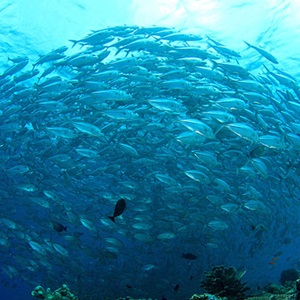The blue MSC label is only applied to wild fish or seafood from fisheries that have been certified to the MSC Fisheries Standard, a set of requirements for sustainable fishing.
Fish and seafood with the blue label comes from a fishery that has been independently assessed on its impacts to wild fish populations and the ecosystems they're part of.
All along the supply chain, MSC certified products are separated from non-certified. MSC certified seafood is accurately labelled, ensuring that seafood with the blue tick comes from fisheries that are MSC certified as fishing sustainably.
Why do we need the MSC label?
Overfishing is a grave threat to our oceans and the reason the MSC and our ecolabel exist. More than a third of fish stocks are estimated to be fished at unsustainable levels.
Overfishing is driven by several factors that will worsen the status of our oceans unless we do something about them.
Seafood is already among the most widely traded food commodities in the world and the demand for seafood is rising as the global population grows
The effects of overfishing are exacerbated by climate change, which is altering marine ecosystems and the habitats that fish depend on. In the North East Atlantic, for example, mackerel stocks are moving northwards as sea temperatures rise.
Harmful fishing subsidies can also contribute to overfishing and are something the MSC believes must be eliminated.
Can we end overfishing by simply not eating fish?
There are likely to be ten billion people on earth by 2050 and it is essential that we harness our precious marine resources sustainably. For millions of people in coastal communities around the world, giving up fishing is simply not an option.
If we manage our fish stocks sustainably, they can recover and thrive. Success stories include the recovery of Namibian hake and the Patagonian toothfish to healthy numbers through careful management.
Research shows that sustainably managed stocks of fish are more productive in the long-term, resulting in a ‘win-win’ for the oceans and for us. Millions of people around the globe rely on seafood as a vital source of protein and for their livelihoods.
What is sustainable seafood?
Sustainable seafood comes from fisheries that catch fish in ways that ensure the long-term health of a stock or species and the wellbeing of the ocean.
We set out requirements for sustainability in the MSC Fisheries Standard. There are more than 500 wild-capture fisheries around the world certified to this standard. To become certified, these fisheries must comply with requirements across three principles:
- only fishing healthy stocks,
- being well-managed so stocks can be fished for the long-term, and
- minimising their impact on other species and the wider ecosystem.
Which fisheries can't be certified?
Fishing which is ineligible and ‘out-of-scope’ of entering assessment to the MSC Fisheries Standard include:
• target amphibians, reptiles, birds and/or mammals
• use destructive fishing practices (such
as poison or explosives)
• have been successfully convicted for forced labour violations within the last two years
• are conducted under a controversial unilateral exemption to an international agreement
• are purely aquaculture (although some forms of enhanced fishery are eligible for assessment)
• have
been convicted of shark finning violations within the last two years
We are currently reviewing the MSC Fisheries Standard which may include revising our criteria for what can be considered as ‘out-of-scope’.
What activity does an MSC certificate cover?
Individual fishers or vessels cannot be MSC certified, only fishing operations. This means fisheries can go out and fish for both MSC certified and non-certified catch but only on separate trips.
An MSC certificate covers a vessel, fleet or individual operator using a certain gear type,
fishing on a particular target stock. All these aspects are taken into account during a fishery assessment to the MSC Fisheries Standard,
and is referred to as the Unit of Certification or UoC.
Vessels, fleets or individual operators fishing outside of the confines of their certification, would not be classed as MSC certified and therefore could not for example sell this catch into the certified supply chain or have these products carry an MSC ecolabel.
Vessels linked to fishing operations that are covered by an MSC certificate are publicly available through a vessel list document submitted for each fishery under ‘assessments’ on our website.
How robust is the MSC’s certification system for sustainable seafood?
Our certification process is independent, verifiable and based on science. We do not directly certify fisheries – they gain certification from an independent assessor and there are multiple opportunities for NGOs and others to contribute to the process.
It can sometimes take years of hard work to improve before a fishery can become MSC certified. Even when a fishery gains certification, this is only the start of the journey. Every year, assessors carry out surveillance reports to check on progress and re-assess fisheries every five years.
Under our Standard requirements, fisheries must improve continuously until they reach what we consider to be the best practice in sustainability. If fisheries do not make the required improvements within a specified time, they can have their certificates suspended until they reach the level of performance required by the MSC Standard.
The fisheries that are MSC certified are often at the forefront of innovations and best practice globally.
How do I know the seafood that I am buying is sustainable?
The MSC blue fish label is only applied to wild fish or seafood products from fisheries that have been certified to the MSC Standard. Our Chain of Custody Standard for supply chain businesses ensures MSC certified fish and seafood is separated from that which is non-certified and is clearly labelled.
More than 7,000 businesses worldwide are MSC Chain of Custody certified, including over 51,000 sites from supermarkets and restaurants to processors, distributors and warehouses. These businesses are audited on an annual basis and subject to unannounced audits, to ensure they are conforming to requirements on traceability, labelling and separation.
The MSC also sometimes commissions independent DNA tests on MSC labelled products to guard against fish fraud, ensuring MSC certified seafood has not been substituted for a different – possibly endangered – species. Research published in the journal Current Biology shows that mislabelling rates on MSC labelled products are less than 1% - significantly lower than other seafood labelling.
What can I do to end overfishing?
Everyone has a part to play. You should look and ask for MSC certified, sustainably sourced seafood when you visit the market, fishmonger or supermarket, or when you eat at a restaurant. The more public pressure there is for sustainable seafood products, the faster that unsustainable fishing practices will be eliminated.
We also want governments to act to end harmful fisheries subsidies which contribute to overfishing, as well as set fishing quotas in line with scientific advice on what is sustainable. We know how to tackle overfishing but we all need to play our part collectively in ending it.



